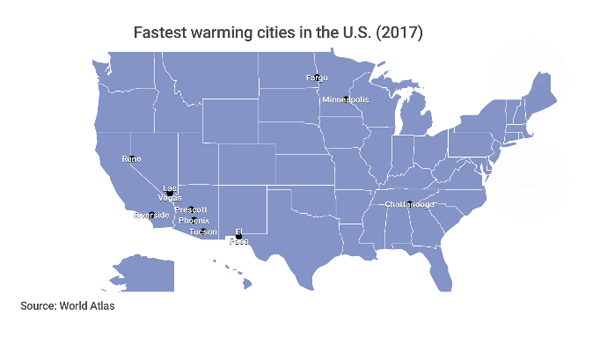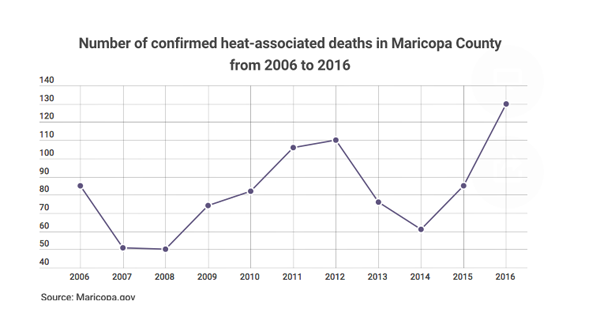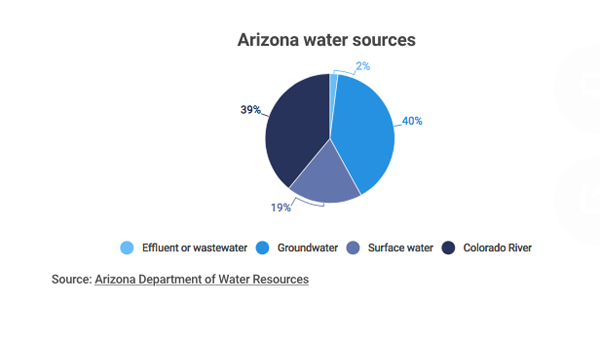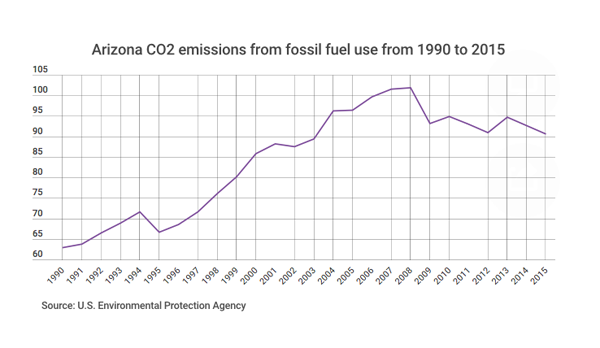
By Katriona Martin | Cronkite News
If you think it’s hot now, just wait: Some climate researchers predict Arizona will be unlivable by 2050.
Not all climate forecasts are so dire, but experts say Arizonans need to prepare for extreme heat and related events. The problem is not centuries in the future, they say, it’s immediate.
Last year was the warmest on record in Arizona, and 2018 is on pace to eclipse that. Experts predict temperatures will rise an additional 10 degrees Fahrenheit over the next seven decades. With more heat, researchers say, comes more air pollution and allergens. The Colorado River reservoirs on which Arizonans depend are expected to dwindle due to rising temperatures and an expanding population, and microorganisms that flourish in extreme heat put those water supplies at risk.
If these predictions, which have been published by the U.S. Bureau of Reclamation and a variety of sources, come true, the health of Arizonans could quickly be at risk, according to the U.S. Centers for Disease Control’s Climate and Health Program website. One Vice reporter even said Phoenix would become unlivable.
“Heat places a lot of stress on the body, and humans and animals need to get some daily relief from the heat,” said Nancy Selover, the state climatologist for Arizona. “If there is no air-conditioned place they can go for relief, people with underlying health problems may be at risk. This is a problem for people with heart conditions, respiratory conditions and the elderly.”
Also of concern are extreme weather events, such as dust storms and heat waves, which are expected to become more common due to climate change and other factors. These events also pose higher risks to human health, according to the CDC.
2017 was the warmest year on record for Arizona, with the hottest day reaching 119 degrees on June 20 – 3 degrees lower than the record set in June 1990. The National Weather Service’s Climate Prediction Center estimates that 2018 will be another record-breaking year. The first month of 2018 was the third warmest January recorded for Phoenix, which is one of the fastest warming cities in the country.
“We are seeing warmer temperatures statewide over the past 30 or so years, both in the daytime temperatures and the nighttime temperatures,” Selover said.
Urban areas are seeing larger temperature increases than rural areas, Selover said. Emissions of CO₂ and other greenhouse gases are among the factors suspected of contributing to increasing temperatures.
“The natural environment of the desert and the irrigated agriculture both cool very quickly at night, so they do not exhibit the warmer nights that the city does,” Selover said. “That is a climate change that is totally attributable to our activities.”

Phoenix is ranked the second-fastest warming city in the United States, according to the World Atlas website – Prescott was fifth and Tucson seventh on the list. Arizona’s 7 million residents already struggle with higher temperatures and hotter seasons, and Selover said it will only get worse for their health.
Preparing now for these events will help “ensure that our communities are adequately prepared for health challenges,” according to the CDC’s Climate and Health Program website.
The following depicts the potential health effects for Arizona residents as climate change and additional factors contribute to the rising temperatures in Arizona. Hover over the data for more information. (Graphics by Katriona Martin/Cronkite News)
Heat
The state’s average temperature is projected to increase by more than 10 degrees Fahrenheit by 2090, according to States at Risk, a project through Climate Central, a nonprofit news organization aimed at showing Americans the impacts of climate change. This means that heat waves could become more common, which will particularly affect Arizonans unable to shelter from the heat. This includes more than 200,000 people living in poverty, ages 5 and younger or 65 and older, who are especially vulnerable to the heat, according to States at Risk. This number is likely to increase if the warming trend continues.

Water and food
As Arizona gets hotter, demand for water will increase, thus reducing the supply.
“We are currently in the 23rd year of a drought,” Selover said. “We have had 37-year dry periods in the past without any warning that might be related to greenhouse gases, so we can’t automatically blame the drought on climate change, but the two are likely related.”
Lake Mead, one of Arizona’s main water sources, is at its lowest level since 2011, according to the USBR.
Arizona relies on what the Environmental Protection Agency calls intermittent, ephemeral and headwater streams (I/E/H) for public drinking water, according to a EPA analysis, but air pollution and growing populations of microorganisms could contaminate those supplies. The Colorado River supplies Arizona with 39 percent of its water, according to the USBR. A water shortage could cause food shortages, which could lead to malnutrition, according to the EPA.

Air
From 1980 to 2015, CO₂ from fossil fuels in Arizona have increased by 38.2 million metric tons. As this number continues to rise, breathing difficulties and respiratory diseases will increase, according to the EPA. According to the National Institutes of Health, air pollution has been associated with respiratory and cardiovascular diseases, as it is a carcinogen to humans.
Allergens also could increase as temperatures rise.
“As air pollutants build up and higher temperatures create more pollen in the air, stronger airborne allergens come with it,” according to the Asthma and Allergy Foundation of America. This may affect those who have severe allergies already, as well as increase the length of allergy seasons, according to Lung.org.

Temperatures may continue to rise in Arizona, so planning ahead and taking care of yourself when outside can help keep you safe and prevent heat-related incidents. Check the Air Quality Index before going outside each day to avoid situations where allergies could be most harmful.











